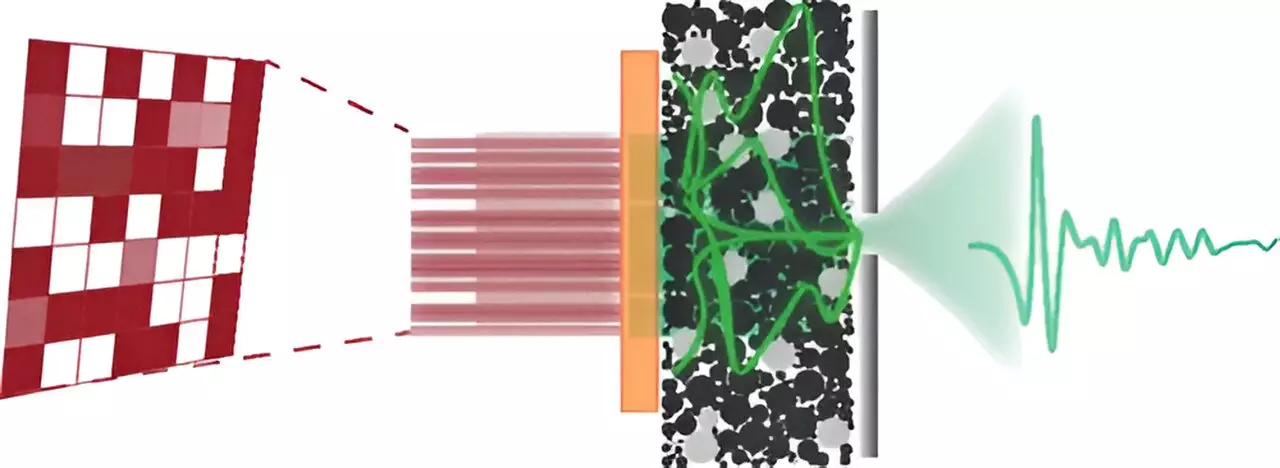In a recent study published in ACS Photonics, a research team from the European Union ERC project TIMING, in collaboration with Prof Jacopo Bertolotti from Exeter University, has developed a groundbreaking technique that allows precise spatiotemporal control of terahertz waves as they pass through disordered materials. This new method could potentially lead to significant advancements in medical imaging, communications, and various other applications that heavily rely on broadband terahertz pulses.
Traditionally, disordered systems such as frosted glass have been perceived as limitations to clarity in the realm of optics. Similar to how fog scatters light and impairs visibility, disordered materials scatter light in unpredictable ways, inhibiting clear imaging. However, a more modern approach has shed light on the potential of these so-called “Complex media.” Despite the scrambled nature of information within these systems, it is not entirely lost. In fact, researchers have discovered that this scattering can be harnessed and utilized to manipulate light itself.
Terahertz waves, a type of electromagnetic radiation with a wavelength between microwaves and infrared light, have proven to be immensely valuable due to their ability to penetrate various materials, including clothing, paper, and plastic. Unlike X-rays, terahertz waves do not cause ionizing damage, making them ideal for obtaining clear images. Furthermore, these waves can also serve as carriers for high-performance communication links. However, their effectiveness is often hindered when they propagate through complex structures such as biological tissue or technological systems.
To overcome the challenges posed by complex media, the research team employed a unique ultrafast laser known for its extremely short pulses. By creating patterns of terahertz pulses and allowing them to interact with scattering materials, the team was able to manipulate the laser’s illumination. They achieved this by utilizing a specially designed genetic algorithm, which mimics natural evolution and is capable of solving complex problems. As a result of this approach, the researchers gained precise control over the distribution of terahertz waves in space and their evolution in time after interacting with the material.
The ability to recompose scrambled wave pieces into desired patterns and colors opens up new possibilities for imaging and sensing applications, where scattering has been a significant challenge. Dr. Vittorio Cecconi, the lead researcher of the study, emphasizes the remarkable potential of complex media as sophisticated devices that manipulate terahertz waves. Despite their seemingly random nature, these systems prove to be highly accessible and hold immense promise for exploiting terahertz waves in various applications.
This cutting-edge technique is made possible by the availability of methods to measure the evolution of terahertz electric fields over time, similar to the function of an oscilloscope. In the realm of photonics, this is a rare occurrence, as the electric field for light is generally not measurable, with the intensity being the commonly accessed quantity through photodetectors. However, the unique methodology known as Nonlinear Ghost Imaging, combined with the capabilities of complex media, enables researchers to gain critical space-time information on waves and their interaction with optical materials.
The Director of the Emergent Photonics Research Center, Prof Peccianti, emphasizes the center’s mission of exploring the intersection between ultrafast photonics and complexity. Through their research, they aim to unlock the untapped potential of various optical phenomena and create innovative solutions that push the boundaries of what is currently possible.
The development of this new technique for precise control of terahertz waves in disordered materials presents a significant advancement in the field of photonics. By harnessing the scattering properties of complex media and utilizing ultrafast lasers and genetic algorithms, researchers have opened up new possibilities for imaging, sensing, and communication applications. The ability to manipulate terahertz waves with precision and overcome the limitations imposed by complex structures paves the way for exciting advancements in various industries.


Leave a Reply